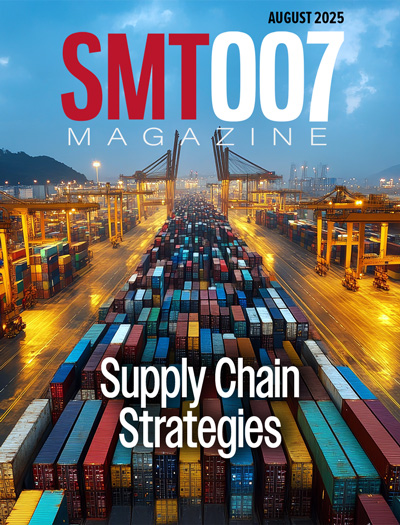-

- News
- Books
Featured Books
- smt007 Magazine
Latest Issues
Current Issue
Spotlight on India
We invite you on a virtual tour of India’s thriving ecosystem, guided by the Global Electronics Association’s India office staff, who share their insights into the region’s growth and opportunities.

Supply Chain Strategies
A successful brand is built on strong customer relationships—anchored by a well-orchestrated supply chain at its core. This month, we look at how managing your supply chain directly influences customer perception.

What's Your Sweet Spot?
Are you in a niche that’s growing or shrinking? Is it time to reassess and refocus? We spotlight companies thriving by redefining or reinforcing their niche. What are their insights?
- Articles
- Columns
- Links
- Media kit
||| MENU - smt007 Magazine
How Do I Get Smart With IPC CFX? (Part 2)
July 31, 2019 | Michael Ford, Aegis Software Corp.Estimated reading time: 10 minutes
Collection of data from manufacturing has long been used to generate reports and create dashboards. The difficulty has always been to piece together and contextualize data acquired both automatically from the disparate machine interfaces as well as from human operators who report events in different ways, especially when they have different roles—such as quality management, line supervision, machine operator, material logistics operator, etc. With CFX, all data is available in an accurate and timely way (Figure 6).
Figure 6: CFX machine-to-factory “big data” example.
The uses of production data are many and varied. Each role within the factory has a different context with which to create and view metrics. With CFX providing the event data, each role in manufacturing can create whatever view of the data that they like with no built-in assumptions.
Using CFX data to make reports brings added value in terms of data accuracy. However, the core value of a historical report is very limited, as it simply details losses that cannot be recovered. The use of the same data to create real-time dashboards can be much more rewarding, as targeted metrics indicate trends in manufacturing as they happen, giving the opportunity to take corrective action before the effects become serious.
But continuously watching dashboards in case an issue should arise is also not a good use of time, so an extension of this allows the software to detect patterns and trends in the data that trigger alarms. The people responsible for dealing with specific exceptions in operation can then be clearly informed as issues arise, no matter where they are or what they are doing.
Industry 4.0 goes one further step, which allows the software to make simple, routine decisions automatically, such as the creation of the Lean “pull” signal to bring materials to the line when needed, or in a complex case, to detect a delivery delay and automatically re-route production to faster resources. To help such decisions, information from every aspect of the factory operation is required. Applications providing such solutions using CFX data are expected to evolve rapidly, providing decision-making support in fast response to changing circumstances, eliminating risk and causes of sub-optimal equipment utilization.
Data from the machines to the factory can also be used to prove compliance and conformance as well as construct the complete digital build record of the production of each individual production unit.
3. CFX Factory-to-Machines, Self-optimization
In isolation, machines and other automated processes are destined to simply follow the set of instructions that they are given. More modern automation comes within a software environment designed to add value to the automation through the acquisition and conversion of engineering data, performing program optimization, job grouping, etc. However, the machine environment software is limited by its ability to gain data from outside of the immediate vendor-controlled environment.
CFX provides the opportunity for any endpoint on the network to subscribe to data from any other machine or factory process. This includes the ability to see both upstream and downstream on the line in which the machine is operating, being able to participate in closed-loops, and also have visibility of production units on their way—all independently of which vendors’ machines are present.
In addition, the machine software can look at other elements that may affect their performance. For example, materials for a placement machine can become a critical issue where a replenishment material may be from a different vendor than the material currently in use on the machine and may have slightly different physical parameters. Even different feeding attributes, such as rotation in the feeder, would result in significant quality issues and/or line disruption if not noticed or accounted for.
With the ability of CFX to bring material data to the attention of the machine software in advance of the physical material arriving, automated compensation for any material changes can be put into place seamlessly, avoiding quality issues and machine downtime. There are many such opportunities for the machine software to obtain information related to the wider operation of the factory, in terms of materials, planning, and scheduling, as well as quality, where safe poka-yoke control can also provide a major benefit through the implementation of active quality management without the risk of compromise to the machine.
4. CFX Transactional Operations
The successful operation of a production line depends on many supporting operations. Placement machines, for example, cannot function without the correct materials being available and set up correctly. The knowledge and management of material availability, verification, and logistics—as well as tools, which include SMT feeders—is essential to not only allow continuous production but also for production optimization. Factory planning in a highly flexible operation needs to be able to react very quickly to changing production demands and changing circumstances, such as a machine breakdown.
To complete critical product deliveries on time often means sudden unexpected changes must be made in the production plan. At these times, it is essential that all of the factors are known about the current production status so that any requirement or consequence of a change can be definitively known and rapid and effective decisions can be made. CFX includes messages related to processes and operations on which production is dependent, enabling management of those key areas and inclusion of them as constraints in any urgent re-planning scenario. Information about these areas is also of key interest for maintenance where CFX enables vendors to monitor work done by machines to plan maintenance tasks and potentially needed spare parts.
The connection of the assembly area with enterprise systems, such as ERP or PLM, is also critical. Traditional enterprise systems have little feedback or understanding of the details of assembly processes and rely on manual correction and “back-flushing” at the end of the operation to understand completions and material usage. The knowledge of intermediate completions and material spoilage, for example, is very limited, which limits the effectiveness of enterprise software. With the use of CFX messaging—especially with MES support—enterprise systems can gain an accurate status of the progress of manufacturing when needed, enhancing their operation and greatly improving the efficiency of the whole factory operation.
Conclusion
The introduction of the CFX standard is the critical trigger that enables smart, flexible factory operation in line with business needs. The technology is simple to adopt, which creates a true “plug-and-play” environment on which advanced production AI software technologies can be developed. Today, we take our network of highways and advanced automobiles for granted. Only movies show us the times where we depended on horses and carts on windy tracks and trails. With CFX as the new standard highway infrastructure for digital manufacturing, the evolution of smart, AI manufacturing applications can now grow, firing on all cylinders.
This article was originally presented at the Technical Proceedings of SMTA International 2018.
Michael Ford is the senior director of emerging industry strategy at Aegis Software.
Page 2 of 2Testimonial
"Our marketing partnership with I-Connect007 is already delivering. Just a day after our press release went live, we received a direct inquiry about our updated products!"
Rachael Temple - AlltematedSuggested Items
U.S. CHIPS Act Funding Detailed on SIA Website
09/12/2025 | Nolan Johnson, I-Connect007The U.S. CHIPS Act has moved well into the implementation stage in 2025. But where has that money gone? The Semiconductor Industry Association has been tracking these projects and provides details on its website. It was updated May. Among the five key programs being managed under CHIPS, two stand out as influencing advanced electronic packaging: the National Advanced Packaging Manufacturing Program (NAPMP), and the CHIPS Manufacturing USA Institute (MFG USA).
Zhen Ding Drives AI-Powered Digital Transformation
09/12/2025 | Zhen DingDriven by the surging demand for computing power fueled by AI, the semiconductor and PCB industries are forging closer integration, expanding their ecosystems, and pursuing shared growth. PCB has already become another NT$ trillion-dollar industry in Taiwan, growing in tandem with the semiconductor sector.
Flex Named to TIME's World's Best Companies List for Third Consecutive Year
09/12/2025 | FlexFlex announced its inclusion on the TIME World's Best Companies 2025 list. This marks the third consecutive year the company was included in this prestigious ranking, which recognizes top-performing companies across the globe.
Secure Semiconductor Manufacturing Acquires Full SMT Line from Manncorp
09/11/2025 | ManncorpSecure Semiconductor Manufacturing, LLC (SSM), an American-owned company dedicated to producing secure printed wiring boards and advanced assembly solutions in the MidWest USA, today announced the acquisition of a complete surface mount technology (SMT) line from Manncorp.
GlobalLogic, Ericsson Deploy Private 5G Network at Hitachi Rail’s State-of-the-Art Digital Factory
09/11/2025 | BUSINESS WIREGlobalLogic Inc., a Hitachi Group company and leader in digital engineering, has designed and deployed a state-of-the-art 5G private network at Hitachi Rail’s most digitally advanced facility in Hagerstown, Maryland, USA.


